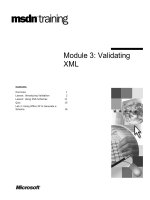Tài liệu Chapter 3 - Application Layer Functionalityand Protocols CCNA Exploration 4.0 docx
Bạn đang xem bản rút gọn của tài liệu. Xem và tải ngay bản đầy đủ của tài liệu tại đây (2.7 MB, 54 trang )
Chapter 3 - Application Layer
Functionalityand Protocols
CCNA Exploration 4.0CCNA Exploration 4.0
Overview
• Describe how the functions of the three upper OSI model layers
provide network services to end user applications.
• Describe how the TCP/IP Application Layer protocols provide the
services specified by the upper layers of the OSI model.
• Define how people use the Application Layer to communicate across
the information network.
• Describe the function of well-known TCP/IP applications, such as the
Học viện mạng Bách khoa - Website: www.bkacad.com
• Describe the function of well-known TCP/IP applications, such as the
World Wide Web and email, and their related services (HTTP, DNS,
SMB, DHCP, STMP/POP, and Telnet).
• Describe file-sharing processes that use peer-to-peer applications and
the Gnutella protocol.
• Explain how protocols ensure services running on one kind of device
can send to and receive data from many different network devices.
• Use network analysis tools to examine and explain how common user
applications work.
Introduction
• Explain that applications provide the means for generating and
receiving data that can be transported on the network.
Học viện mạng Bách khoa - Website: www.bkacad.com
OSI model
• To address the problem of network incompatibility, the International
Học viện mạng Bách khoa - Website: www.bkacad.com
• To address the problem of network incompatibility, the International
Organization for Standardization (ISO) researched networking models like
Digital Equipment Corporation net (DECnet), Systems Network Architecture
(SNA), and TCP/IP in order to find a generally applicable set of rules for all
networks.
• Using this research, the ISO created a network model that helps vendors
create networks that are compatible with other networks.
• The Open System Interconnection (OSI) reference model released in 1984
was the descriptive network model that the ISO created.
• It provided vendors with a set of standards that ensured greater compatibility
and interoperability among various network technologies produced by
companies around the world.
The OSI Model
• Initially the OSI model was designed by the International Organization for
Standardization (ISO) to provide a framework on which to build a suite of open
systems protocols.
Học viện mạng Bách khoa - Website: www.bkacad.com
The OSI Model
Học viện mạng Bách khoa - Website: www.bkacad.com
OSI model
• Explain the role of applications, services and protocols in converting
communication to data that can be transferred across the data network.
• Application layer: It is the layer that provides the interface between the
applications we use to communicate and the underlying network over
which our messages are transmitted.
Học viện mạng Bách khoa - Website: www.bkacad.com
OSI model
Học viện mạng Bách khoa - Website: www.bkacad.com
OSI model
Học viện mạng Bách khoa - Website: www.bkacad.com
OSI and TCP/IP Model
• Functionality of the TCP/IP application layer protocols fit roughly into
the framework of the top three layers of the OSI model: Application,
Presentation and Session layers.
Học viện mạng Bách khoa - Website: www.bkacad.com
OSI and TCP/IP Model
• The Presentation layer has three primary functions:
1. Coding and conversion of Application layer data to ensure that
data from the source device can be interpreted by the appropriate
application on the destination device.
2. Compression of the data in a manner that can be decompressed
Học viện mạng Bách khoa - Website: www.bkacad.com
2. Compression of the data in a manner that can be decompressed
by the destination device.
3. Encryption of the data for transmission and the decryption of data
upon receipt by the destination.
Example: QuickTime, Motion Picture Experts Group (MPEG),
Graphics Interchange Format (GIF), Joint Photographic Experts
Group (JPEG)…
OSI and TCP/IP Model
The Session Layer
• Functions at this layer create and maintain dialogs between source and
destination applications.
• The Session layer handles the exchange of information to initiate
dialogs, keep them active, and to restart sessions that are disrupted or
Học viện mạng Bách khoa - Website: www.bkacad.com
dialogs, keep them active, and to restart sessions that are disrupted or
idle for a long period of time.
Application Layer Protocols
• These protocols specify the format and control information necessary
for many of the common Internet communication functions. Among
these TCP/IP protocols are:
– Domain Name Service Protocol (DNS).
– Hypertext Transfer Protocol (HTTP).
– Simple Mail Transfer Protocol (SMTP).
– Telnet.
Học viện mạng Bách khoa - Website: www.bkacad.com
– Telnet.
– File Transfer Protocol (FTP).
Application Layer Software
• The functions associated with the Application layer protocols enable
our human network to interface with the underlying data network.
• Within the Application layer, there are two forms of software programs
or processes that provide access to the network: applications and
services.
Học viện mạng Bách khoa - Website: www.bkacad.com
User applications, Services, and Application Layer Protocols
• The Application layer uses protocols that are implemented within
applications and services.
• While applications provide people a way to create messages and
application layer services establish an interface to the network,
protocols provide the rules and formats that govern how data is treated.
Học viện mạng Bách khoa - Website: www.bkacad.com
Application Layer Protocol Functions
• Application layer protocols are used by both the source
and destination devices during a communication session.
Học viện mạng Bách khoa - Website: www.bkacad.com
The Client-Server Model
• In the client/server model, the device requesting the information is
called a client and the device responding to the request is called a
server. Client and server processes are considered to be in the
Application layer.
Học viện mạng Bách khoa - Website: www.bkacad.com
Servers
• In a general networking context, any device that responds to requests from
client applications is functioning as a server.
• A server is usually a computer that contains information to be shared with
many client systems.
• Different types of server applications may have different requirements for
client access.
• Some servers may
require authentication of
Học viện mạng Bách khoa - Website: www.bkacad.com
require authentication of
user account information
to verify if the user has
permission to access the
requested data or to use
a particular operation.
Application Layer Services and Protocols
• A single application may employ many different supporting Application
layer services.
• Additionally, servers typically have multiple clients requesting
information at the same time.
Học viện mạng Bách khoa - Website: www.bkacad.com
Peer-to-Peer Networking and Applications (p2p)
The Peer-to-Peer Model
• Peer-to-peer networking involves two distinct forms: peer-to-peer network
design and peer-to-peer applications (P2P). Both forms have similar features
but in practice work very differently.
Peer-to-Peer Networks
• In a peer-to-peer network, two or more computers are connected via a network
and can share resources (such as printers and files) without having a
dedicated server.
Học viện mạng Bách khoa - Website: www.bkacad.com
dedicated server.
Peer-to-Peer Networking and Applications (p2p)
Peer-to-Peer Applications
• A peer-to-peer application (P2P), unlike a peer-to-peer network, allows a
device to act as both a client and a server within the same communication.
• In this model, every client is a server and every server a client. Both can initiate
a communication and are considered equal in the communication process.
• Peer-to-peer applications can be used on peer-to-peer networks, client/server
networks, and across the Internet.
Học viện mạng Bách khoa - Website: www.bkacad.com
Application Layer Protocols and Services Examples
• Now that we have a better understanding of how applications provide
an interface for the user and provide access to the network, we will
take a look at some specific commonly used protocols.
• Some of these services are:
– Domain Name System (DNS) - TCP/UDP Port 53
– Hypertext Transfer Protocol (HTTP) - TCP Port 80
– Simple Mail Transfer Protocol (SMTP) - TCP Port 25
Học viện mạng Bách khoa - Website: www.bkacad.com
– Simple Mail Transfer Protocol (SMTP) - TCP Port 25
– Post Office Protocol (POP) - UDP Port 110
– Telnet - TCP Port 23
– Dynamic Host Configuration Protocol - UDP Port 67
– File Transfer Protocol (FTP) - TCP Ports 20 and 21
DNS Services and Protocol
Học viện mạng Bách khoa - Website: www.bkacad.com
• A domain naming system was developed in order to associate the
contents of the site with the address of that site. The Domain Name
System (DNS) is a system used on the Internet for translating names
of domains and their publicly advertised network nodes into IP
addresses.
DNS Services and protocol
• The Domain Name System (DNS) was created for domain name to
address resolution for these networks. DNS uses a distributed set of
servers to resolve the names associated with these numbered
addresses.
• The DNS protocol defines an automated service that matches resource
names with the required numeric network address.
• DNS protocol communications use a single format called a message.
Học viện mạng Bách khoa - Website: www.bkacad.com
• DNS protocol communications use a single format called a message.
• DNS is used for all types of client queries and server responses, error
messages, and the transfer of resource record information between
servers.
DNS - Example
Học viện mạng Bách khoa - Website: www.bkacad.com









